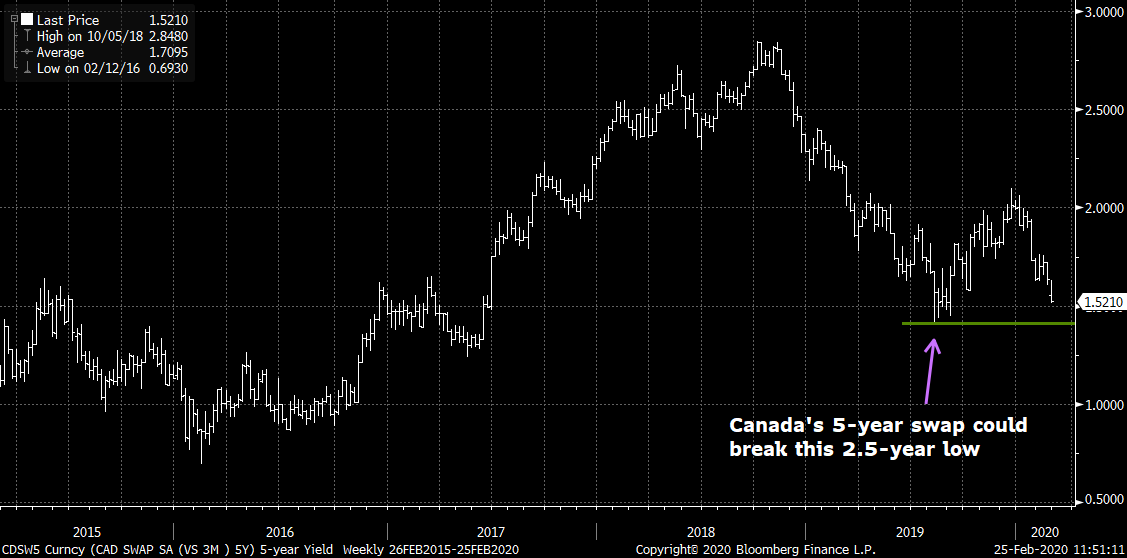One of the best short-term leading indicators of 5-year fixed mortgage rates is making a beeline towards a 2.5-year low.
Canada’s 5-year swap rate is now just 1/10th of a percentage point away from this key threshold, which, if broken, will lead to further fixed-rate cuts.

Banks routinely price fixed mortgages against swaps, which are interest rate derivatives used to hedge interest rate exposure.
The coronavirus is driving swap rates lower than many expected just days ago.
There’s now no doubt that this global outbreak has the potential to take fixed rates down another 1/4 to 1/2 point, if not more.
As for the Bank of Canada and prime rate, Capital Economics says this:
“While the further spread of the Covid-19 virus increases the chance of interest rate cuts, the Bank of Canada seems likely to approach the issue in the same way that it approached the US-China trade war. The Bank hinted several times last year that it was ready to act in response to the trade war threat but, due to the risk that looser policy could pour further fuel on the surging housing market, was not prepared to cut interest rates unless it saw weakness in the data.”
This March is going to be must-see TV in the mortgage rate world.
Beware “No Float-Down” Rules
Starting by April, the government—as part of its new stress test rules—will start publishing Canada’s median insured 5-year fixed rate. It’ll do so each week and people will start following it closely.
 That will lead borrowers who already have a rate hold to increasingly shop their lender after approval. The goal being to ensure they’re saving as much as possible.
That will lead borrowers who already have a rate hold to increasingly shop their lender after approval. The goal being to ensure they’re saving as much as possible.
Lenders who impose “no float-down policies” will then have some decisions to make. Borrowers who are increasingly aware of rate moves will start to demand lower rates, when applicable. Will such lenders cave and make exceptions to their policies more often — i.e., allow approved borrowers to reset their rates lower before closing?
Jargon Buster: Lenders with “no float-down” policies do not allow for rate drops after approval. If you’ve got a $200,000 mortgage and rates fall 0.15% before you close, not being able to “float down” your rate means you’re foregoing roughly $1,400 in interest savings.
If regularly published benchmark rates lead to more rate shopping after approval, lenders who rigidly enforce no float-down policies will lose customers. We could ultimately see such policies fall by the wayside. And believe me, that would be welcomed by borrowers and mortgage advisors alike.

 log in
log in
14 Comments
Rate Spy Team,
What would you advise customer to pick from the following 2 options even if no plan to sell the home in next 5 years?
(A) 2.33% 5 yr fixed
(B) 2.55% 5 yr. Variable (2.65 – Cashback)
(A) 2.33% 5 yr fixed
(B) 2.55% 5 yr. Variable (2.65 – Cashback)
WHO has those rates?
Hi Miguel, They’re for insured mortgages only.
5yr fixed: https://www.ratespy.com/best-mortgage-rates/500000/450000/25/any/+29/no/5-year/fixed
Variable: https://www.ratespy.com/best-mortgage-rates/500000/450000/25/any/+29/no/5-year/variable
I wonder if rates could get below 2%
Definitely could / likely will. Just a question of how many months/years.
Hi Spy,
Looking back at the 5yr Gov rate, for a good part of 2016 the rate was below 1%.
Can you use your time machine to go back and give us a refresher on what the fixed and floating mortgage rates were back then.
Maybe a min and max and mean rate for the period of Feb to May 2016 since this is the hot housing time.
I know past performance is not an indicator of future performance, but it could give us some idea of what to expect over the next few months if the 5 yr Gov rate stays low or goes lower.
Feel free to use your data tables from back then but a time machine sounds way cooler, especially if it is in the back of a Delorean
Thanks
Hi Ray,
My flux-capacitor is on the fritz but here’s what I can tell you. The all-time low in the 5yr yield (0.39%) occurred on February 11, 2016. At the end of that month the lowest advertised 5yr fixed was 2.28% and the lowest advertised 5yr variable was 2.03%. Both through brokers.
Hope that helps. For more historical rates check out our “Historical Rates” feature on this page: https://www.ratespy.com/best-mortgage-rates (Click “Advanced Options” on the left hand side.)
If my mortgage is renewing in near future, do I have to buy mortgage INSURANCE to be entitled for low interest fixed 5yrs? (currently I don’t have mortgage insurance)
Hi Bill,
A borrower can pay for what they call “transactional insurance” and get a lower “insured” rate, but it rarely makes sense.
You’re usually better off paying the higher “uninsured” rate and saving on the insurance premium.
Depending on your home value and mortgage amount, you might also qualify for “insurable” rates where the lender pays the default insurance premium (a.k.a. “bulk insurance premium”) for you. This often qualifies a borrower for better pricing than uninsured rates.
Borrowers who input their particulars into this page will typically see the lowest applicable published rates (that we’re aware of): https://www.ratespy.com/best-mortgage-rates
Just be sure to read the rate notes because some of the cheapest specials are for purchases only, or have other restrictions.
Spy,
I couldn’t get your response to my question earlier so following up.
What would you advise customer to pick from the following 2 options even if no plan to sell the home in next 5 years?
(A) 2.33% 5 yr fixed
(B) 2.55% 5 yr. Variable (2.65 – Cashback)
Thank you.
Hi Tejas, We can’t give 1-in-1 advice in this forum but have a look at this: https://www.ratespy.com/amid-pandemic-potential-5-year-fixed-or-variable-022711935
Thanks for the tip on the historical rates, I did not know that feature was down in the advanced section
I also get the same question as Tejas quite often.
Spy, thanks for the link to the “Amid Pandemic Potential” article. Great resource.
Thanks Frank. Glad it was useful.